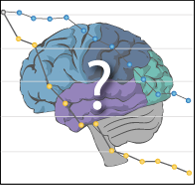Archive for the ‘Commentary’ Category
Wednesday, April 29th, 2009
 Some years ago the parent of an ADHD child we had trained told us, “I would have given my house for what you have done for my child.” Nowadays such sentiments are more likely to be expressed by parents of autistic children. Not every person who pays for our services feels this way, but clearly a lot of people recognize that the value of neurofeedback bears no relationship to its costs. There’s no way to put a dollar value on the recovery of function in traumatic brain injury, dementia, or psychological trauma, or in the case of developmental delay. Some years ago the parent of an ADHD child we had trained told us, “I would have given my house for what you have done for my child.” Nowadays such sentiments are more likely to be expressed by parents of autistic children. Not every person who pays for our services feels this way, but clearly a lot of people recognize that the value of neurofeedback bears no relationship to its costs. There’s no way to put a dollar value on the recovery of function in traumatic brain injury, dementia, or psychological trauma, or in the case of developmental delay.
This presents no problem to the economist who sees the price of an item as giving us the best measure of what it is actually worth. But we do have a problem in the economic modeling of health care precisely because perceived value is so out of line with costs. This is true across the board, and most particularly when it comes to life-saving medical interventions, or procedures that extend our useful lives further into the future. There’s almost no limit to what most individuals would wish to have done in order to recover function, and to extend useful life expectancy. What would Howard Hughes, for example, have been willing to do for his obsessive-compulsive condition? (If only he had had neurofeedback!)
Can one put this in terms that an economist can work with? The mother at the beginning of this tale saw the value to her child as equal to the value of her house, which probably constitutes the bulk of her assets. All of our tangible assets taken together probably amount to some five to ten times our annual GNP, give or take a housing and stock market bubble. So even if most people would be willing to pony up only some ten percent of their assets to assure the desired outcome of a critical medical or rehabilitative procedure, the total value still comes to something comparable to our whole GNP. One could go on to construct a wholly different GNP based not on actual prices but rather on perceived value of what the economy actually produces. Let’s call this a virtual GNP, on the basis of which one could envision a virtual economy of the future in which such value judgments would have a greater policy impact. We can see how that might go in the case of health care:
(more…)
Posted in Application of Neurofeedback, Commentary, Neurofeedback | 5 Comments »
Friday, March 13th, 2009
 Several disjoint pieces of information have been intruding on my consciousness for some while. At last year’s NBA finals, a courtside seat at Staples Center went for more than $27,000. That was for a single game. At about the same time, I noticed an ad informing readers that the 99cent store also had a bridal registry. These nuggets nicely encapsulate the two economic realms that coexist in our nation, particularly in our cities. The pattern is replicated abroad. In the world at large, there are enough cell phones for two-thirds of the world’s population, while the remaining one-third lives on less than $2 per day. When it comes to meeting basic survival needs, the amounts required are modest indeed, even in our society. Several disjoint pieces of information have been intruding on my consciousness for some while. At last year’s NBA finals, a courtside seat at Staples Center went for more than $27,000. That was for a single game. At about the same time, I noticed an ad informing readers that the 99cent store also had a bridal registry. These nuggets nicely encapsulate the two economic realms that coexist in our nation, particularly in our cities. The pattern is replicated abroad. In the world at large, there are enough cell phones for two-thirds of the world’s population, while the remaining one-third lives on less than $2 per day. When it comes to meeting basic survival needs, the amounts required are modest indeed, even in our society.
There are several implications. First of all, the economy we have is largely discretionary. Secondly, if the people at the bottom lose their livelihood, this can get lost in the economic aggregates. We cannot look to the aggregate economic pulse as an index to suffering. We have to look for it directly. The signposts are everywhere. A car’s windshield is smashed to yield an old iPod that is worth perhaps $30 on the street. A man slashes all the tires in a parking lot–no doubt the signature of seething resentments. A father kills himself and his family because of a $6,000 debt that he cannot cover.
The Fed is projecting on the order of 1.2% decline in economic aggregates for the year. Of course Fed projections are really lagging indicators. It does not want to be harbinger of bad news. But even if things turn out to be even three to six times worse, somehow that does not seem sufficient to put our society into crisis. The real crisis in fact lies elsewhere. At the bottom end, we have people falling out of the cash economy into penury. At the top end, we have the collapse of asset valuations. And in the middle we have a lot of stress and angst.
(more…)
Posted in Application of Neurofeedback, Commentary, Neurofeedback | 7 Comments »
Monday, January 26th, 2009
 The inauguration of President Barack Obama was another one of those rare events that draws our individual nervous systems into collective patterns of activity all the way across the nation. David Kaiser did his dissertation on this general topic, monitoring a number of EEGs while a movie was being watched to determine the degree to which common and reproducible EEG activity was evoked as emotionally gripping scenes were on-screen. Ever since, I have on occasions like this imagined EEGs moving in a kind of unison across the country as we all watch the same emotionally evocative event at the same time. The inauguration of President Barack Obama was another one of those rare events that draws our individual nervous systems into collective patterns of activity all the way across the nation. David Kaiser did his dissertation on this general topic, monitoring a number of EEGs while a movie was being watched to determine the degree to which common and reproducible EEG activity was evoked as emotionally gripping scenes were on-screen. Ever since, I have on occasions like this imagined EEGs moving in a kind of unison across the country as we all watch the same emotionally evocative event at the same time.
A bias intrudes here however, in that good feelings tend not to be transitory or episodic, but rather to persist over time. So they are less likely to be noticeable in the EEG as sudden shifts than when we are dealing with negative or aversive events. Thus, our concern when Chief Justice Roberts flubbed his lines probably registered more strongly in our EEGs than the more persistent good feeling about the transition of power that was symbolized in the giving of the oath.
Then came the sober inaugural address, in which the dire circumstances in which the nation finds itself needed to be couched in palatable terms. How does one maintain optimism at a time like this? No one did this better than Franklin Roosevelt in his day, and no one does it better than Barack Obama now. Neither, however, had a substantive basis for optimistic projections beyond the notion that America usually finds its way out of the muddles it makes. This is not merely our self-delusion. Outsiders have the same impression. Said Bismarck: “God looks after drunks, little children, and the United States of America.” Or Churchill: “America usually solves its problems, after trying everything else first.” (more…)
Posted in Application of Neurofeedback, Commentary, Neurofeedback, Professional Issues | 1 Comment »
Wednesday, December 17th, 2008
 Our infra-low frequency training is sending ripples through the field of neurofeedback because it appears to represent such a fundamental departure from prevailing models. It is at such a bifurcation point that a professional community is tested in its assumptions, in its procedures, in its processes for finding accommodation, and indeed in its humanity. Unfortunately, the field of neurofeedback already has a history of fragmentation behind it. Therefore history does not augur for a benign accommodation to our new findings. More than likely we will just be in for continuing Balkanization of our field. Our infra-low frequency training is sending ripples through the field of neurofeedback because it appears to represent such a fundamental departure from prevailing models. It is at such a bifurcation point that a professional community is tested in its assumptions, in its procedures, in its processes for finding accommodation, and indeed in its humanity. Unfortunately, the field of neurofeedback already has a history of fragmentation behind it. Therefore history does not augur for a benign accommodation to our new findings. More than likely we will just be in for continuing Balkanization of our field.
The first response has been skepticism, much of it animated by the thought that this new approach has just suddenly sprung upon the scene without sufficient research and scientific support. In fact, of course, the infra-low training is just the culmination of a long development process that goes back more than ten years. There have been many milestones along the way, each of which was well-established both clinically and scientifically before we moved on. In particular, our march to probe the low-frequency training has taken place in five distinct epochs over that period of time. We have now been exploring the domain below 1.5 Hz for more than two years, and the domain below 0.05 Hz for more than one year.
Our new findings present the greatest “affront” to the classical QEEG perspective, namely that the guide to neurofeedback protocol is to be found in the stationary deviations in QEEG variables from established norms. The hope has been that the QEEG formalism would give neurofeedback the necessary rigor, predictability, and reproducibility to finally achieve respectability in polite circles. This has not yet happened. Under the pressure of rejection, the response has been to adhere to the model with ever greater rigor, all the while critiquing other neurofeedback modalities that were not compliant. Unfortunately, the QEEG perspective has the propensity to become a kind of closed system that confers validity on its own data preferentially. Because the belief system was the prime mover here, there has been a tendency to recognize data that supports the model and to dismiss data that contradicts it. (more…)
Posted in Application of Neurofeedback, Commentary, Efficacy, Neurofeedback | 3 Comments »
Thursday, June 5th, 2008
 Neurofeedback is reaching the threshold of mainstream acceptance, so we are going through a kind of ‘darkness before dawn’ phenomenon right now where critics are at their most strident. My inclination is increasingly to ignore these criticisms and attend to the business of growing the field, but inevitably the criticisms grate, and they evoke the urge to respond. Neurofeedback is reaching the threshold of mainstream acceptance, so we are going through a kind of ‘darkness before dawn’ phenomenon right now where critics are at their most strident. My inclination is increasingly to ignore these criticisms and attend to the business of growing the field, but inevitably the criticisms grate, and they evoke the urge to respond.
This is particularly the case when the source of the criticism comes from the most disinhibited technology enthusiasts, the producers of the magazine Wired. When a writer recently approached them about doing an article on neurofeedback, the editor asked what event or new finding would make such an article relevant at this particular moment. The fact that the magazine has never dealt with neurofeedback at all was not seen as an oversight needing correction.
With that background, one might well ask what new finding or event might have triggered them to have Daniel Carlat write an article that trashes fMRI, SPECT, and QEEG as essentially useless. “Don’t believe the hype,” says the subheading, which is strange coming from a magazine full of hype that is impossible to assess at the time of printing. The ‘hype’ in this case relates to functional imagery and its potential role in psychiatry. The article does not touch on neurofeedback. (more…)
Posted in Commentary | 1 Comment »
Thursday, May 29th, 2008
 Some years ago, the Economist Magazine covered the nascent neurotechnologies and came up somewhat alarmed about our potential futures. If people were concerned about such issues as genetically modified foods, stem cell research, genetic screening, etc., they should really be worried about what the future has in store with regard to the alteration of brain function. That future looked really scary for its loosening of the moorings on who we are and who might have the power to shape our individual futures. Some years ago, the Economist Magazine covered the nascent neurotechnologies and came up somewhat alarmed about our potential futures. If people were concerned about such issues as genetically modified foods, stem cell research, genetic screening, etc., they should really be worried about what the future has in store with regard to the alteration of brain function. That future looked really scary for its loosening of the moorings on who we are and who might have the power to shape our individual futures.
Now it is several years later, and the Economist sounds a very different tone in discussing the potential of brain-altering drugs that may enhance memory, concentration, and learning. Our future with “cognition enhancers” seems almost entirely positive. We are having our first relevant experience even now as existing drugs are being used “off-label” by populations that carry no diagnosis. “Provigil and Ritalin really do enhance cognition in healthy people,” urges the Economist. Provigil can add about a digit to one’s digit span and both Provigil and Ritalin can enhance executive function. (more…)
Posted in Commentary, Neurofeedback, Professional Issues | 4 Comments »
|
|
Subscribe to Email Newsletter
The EEG Info Newsletter circulates via email at least once a month. A variety of topics related to the Neurofeedback / EEG Biofeedback field are covered in over 200 articles.
|
 Several disjoint pieces of information have been intruding on my consciousness for some while. At last year’s NBA finals, a courtside seat at Staples Center went for more than $27,000. That was for a single game. At about the same time, I noticed an ad informing readers that the 99cent store also had a bridal registry. These nuggets nicely encapsulate the two economic realms that coexist in our nation, particularly in our cities. The pattern is replicated abroad. In the world at large, there are enough cell phones for two-thirds of the world’s population, while the remaining one-third lives on less than $2 per day. When it comes to meeting basic survival needs, the amounts required are modest indeed, even in our society.
Several disjoint pieces of information have been intruding on my consciousness for some while. At last year’s NBA finals, a courtside seat at Staples Center went for more than $27,000. That was for a single game. At about the same time, I noticed an ad informing readers that the 99cent store also had a bridal registry. These nuggets nicely encapsulate the two economic realms that coexist in our nation, particularly in our cities. The pattern is replicated abroad. In the world at large, there are enough cell phones for two-thirds of the world’s population, while the remaining one-third lives on less than $2 per day. When it comes to meeting basic survival needs, the amounts required are modest indeed, even in our society.
 The inauguration of President Barack Obama was another one of those rare events that draws our individual nervous systems into collective patterns of activity all the way across the nation. David Kaiser did his dissertation on this general topic, monitoring a number of EEGs while a movie was being watched to determine the degree to which common and reproducible EEG activity was evoked as emotionally gripping scenes were on-screen. Ever since, I have on occasions like this imagined EEGs moving in a kind of unison across the country as we all watch the same emotionally evocative event at the same time.
The inauguration of President Barack Obama was another one of those rare events that draws our individual nervous systems into collective patterns of activity all the way across the nation. David Kaiser did his dissertation on this general topic, monitoring a number of EEGs while a movie was being watched to determine the degree to which common and reproducible EEG activity was evoked as emotionally gripping scenes were on-screen. Ever since, I have on occasions like this imagined EEGs moving in a kind of unison across the country as we all watch the same emotionally evocative event at the same time. Our infra-low frequency training is sending ripples through the field of neurofeedback because it appears to represent such a fundamental departure from prevailing models. It is at such a bifurcation point that a professional community is tested in its assumptions, in its procedures, in its processes for finding accommodation, and indeed in its humanity. Unfortunately, the field of neurofeedback already has a history of fragmentation behind it. Therefore history does not augur for a benign accommodation to our new findings. More than likely we will just be in for continuing Balkanization of our field.
Our infra-low frequency training is sending ripples through the field of neurofeedback because it appears to represent such a fundamental departure from prevailing models. It is at such a bifurcation point that a professional community is tested in its assumptions, in its procedures, in its processes for finding accommodation, and indeed in its humanity. Unfortunately, the field of neurofeedback already has a history of fragmentation behind it. Therefore history does not augur for a benign accommodation to our new findings. More than likely we will just be in for continuing Balkanization of our field. Neurofeedback is reaching the threshold of mainstream acceptance, so we are going through a kind of ‘darkness before dawn’ phenomenon right now where critics are at their most strident. My inclination is increasingly to ignore these criticisms and attend to the business of growing the field, but inevitably the criticisms grate, and they evoke the urge to respond.
Neurofeedback is reaching the threshold of mainstream acceptance, so we are going through a kind of ‘darkness before dawn’ phenomenon right now where critics are at their most strident. My inclination is increasingly to ignore these criticisms and attend to the business of growing the field, but inevitably the criticisms grate, and they evoke the urge to respond. Some years ago, the Economist Magazine covered the nascent neurotechnologies and came up somewhat alarmed about our potential futures. If people were concerned about such issues as genetically modified foods, stem cell research, genetic screening, etc., they should really be worried about what the future has in store with regard to the alteration of brain function. That future looked really scary for its loosening of the moorings on who we are and who might have the power to shape our individual futures.
Some years ago, the Economist Magazine covered the nascent neurotechnologies and came up somewhat alarmed about our potential futures. If people were concerned about such issues as genetically modified foods, stem cell research, genetic screening, etc., they should really be worried about what the future has in store with regard to the alteration of brain function. That future looked really scary for its loosening of the moorings on who we are and who might have the power to shape our individual futures.
The Virtual Economy
Wednesday, April 29th, 2009This presents no problem to the economist who sees the price of an item as giving us the best measure of what it is actually worth. But we do have a problem in the economic modeling of health care precisely because perceived value is so out of line with costs. This is true across the board, and most particularly when it comes to life-saving medical interventions, or procedures that extend our useful lives further into the future. There’s almost no limit to what most individuals would wish to have done in order to recover function, and to extend useful life expectancy. What would Howard Hughes, for example, have been willing to do for his obsessive-compulsive condition? (If only he had had neurofeedback!)
Can one put this in terms that an economist can work with? The mother at the beginning of this tale saw the value to her child as equal to the value of her house, which probably constitutes the bulk of her assets. All of our tangible assets taken together probably amount to some five to ten times our annual GNP, give or take a housing and stock market bubble. So even if most people would be willing to pony up only some ten percent of their assets to assure the desired outcome of a critical medical or rehabilitative procedure, the total value still comes to something comparable to our whole GNP. One could go on to construct a wholly different GNP based not on actual prices but rather on perceived value of what the economy actually produces. Let’s call this a virtual GNP, on the basis of which one could envision a virtual economy of the future in which such value judgments would have a greater policy impact. We can see how that might go in the case of health care:
(more…)
Posted in Application of Neurofeedback, Commentary, Neurofeedback | 5 Comments »